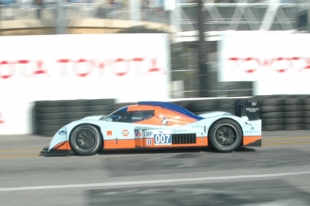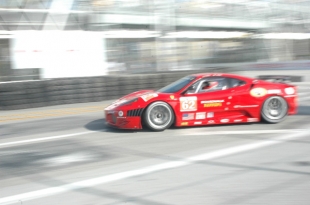 Photos by Nate Toering
Photos by Nate Toering
For today’s American Le Mans Series race at the Grand Prix of Long Beach, two prototype classes and two sports car classes were combined into one each to make the playing fields more even. Where before those cars would produce four class winners, now there will only be one each.
In the LMP prototype class, the more powerful but heavier P1 cars were supposed to be at a disadvantage to the smaller, quicker P2 cars. Many expected the lighter P2 cars to dominate on the low speed, 11-turn Long Beach street course.
 Somebody forgot to tell the Aston Martin 007.
Somebody forgot to tell the Aston Martin 007.
The large, sultry Aston with loud blue/orange styling and an orchestra-quality V-12 engine in the back tore through the track to earn pole position for Saturday’s race. Three P2 cars followed closely behind in the #1 Acura ARX-01c, the #16 Mazda B09 and the #6 Porsche RS Spyder.
Adrian Fernandez and the Aston Martin beat out David Brabham and the Acura by just .072 seconds, building anticipation that the ALMS race will be tight down to the wire.
In a racing series that features so many cars of different levels and abilities, good passing is crucial as faster cars need to get around slower cars in order to maintain good pace. On Saturday, a record 35 cars will take to the track and could slow the speed of the race considerably – making it easier for cars to catch up to the leaders. That should make Aston Martin very nervous with the lightning-quick P2 cars on its tail.
 In the sports car class known as GT, the bright red #62 Ferrari F430 of Jaime Melo captured the top spot, followed by Bryan Sellers’ #17 Porsche 911 GT3 RSR and the #3 Corvette C6.R of Jan Magnussen. The GT class will be highly competitive, as well, especially with Corvette drivers looking to avenge last week’s miscue during the 12-hour race in Sebring that caused the team’s two cars to crash into each other in pit lane, ruining the cars’ debut in the GT class.
In the sports car class known as GT, the bright red #62 Ferrari F430 of Jaime Melo captured the top spot, followed by Bryan Sellers’ #17 Porsche 911 GT3 RSR and the #3 Corvette C6.R of Jan Magnussen. The GT class will be highly competitive, as well, especially with Corvette drivers looking to avenge last week’s miscue during the 12-hour race in Sebring that caused the team’s two cars to crash into each other in pit lane, ruining the cars’ debut in the GT class.
The Grand Prix of Long Beach will present a challenge to all cars in the American Le Mans Series, regardless of class. That’s because these cars are typically designed to handle the rigors of high-speed endurance racing, such as the 12 Hours of Sebring or the world-famous 24 Hours of Le Mans in France. Saturday’s race will last just 100 minutes on a highly-unusual street course. Expect to see lots of jockeying for position, which makes for very exciting racing and a chance to see the world’s most advanced sports cars battling it out on the streets of Long Beach.
With so many different classes of cars, the American Le Mans Series race can be a bit confusing. Here’s a helpful guide when you’re watching the race today:
LMP: Very high-speed prototype cars that sit low to the ground with large rear wings, often with open cockpits.
LMPC: Very similar to the LMP class, although these cars are all versions of the Oreca FLM 09 and are slower.
GT: Sports cars based on production vehicles like the Ferrari F430, the Porsche 911, the BMW M3, the Chevrolet Corvette and the Ford GT.
GTC: Similar to the GT class Porsches, these cars are all versions of the Porsche GT3 Cup and are slower than the GT class cars.
